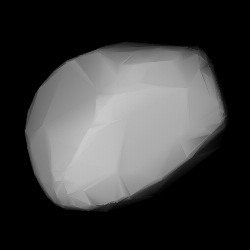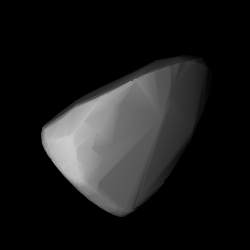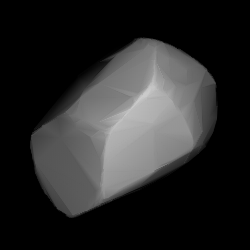Related Research Articles
3728 IRAS, provisional designation 1983 QF, is a stony asteroid from the middle region of the asteroid belt, approximately 20 kilometers in diameter. On 23 August 1983, it was discovered by and later named after IRAS, a spaceborne all-sky infrared survey satellite.
1018 Arnolda, provisional designation 1924 QM, is a stony asteroid from the central regions of the asteroid belt, approximately 16 kilometers in diameter. It was discovered on 3 March 1924, by German astronomer Karl Reinmuth at the Heidelberg-Königstuhl State Observatory in southwest Germany. The asteroid was named after physicist Arnold Berliner.

1094 Siberia is an Eunomian asteroid from the central regions of the asteroid belt. It was discovered on 12 February 1926, by Soviet astronomer Sergey Belyavsky at the Simeiz Observatory on the Crimean peninsula. The X-type asteroid (Xk) has a rotation period of 21.2 hours and measures approximately 18 kilometers in diameter. It was named after the vast region of Siberia in North Asia.
1675 Simonida, provisional designation 1938 FB, is a stony Florian asteroid from the inner regions of the asteroid belt, approximately 11 kilometers in diameter. Discovered by Milorad Protić in 1938, it was later named after the medieval Byzantine princess Simonida.

1554 Yugoslavia, provisional designation 1940 RE, is a stony Eunomian asteroid from the middle region of the asteroid belt, approximately 16 kilometres (9.9 mi) in diameter. It was discovered by Serbian astronomer Milorad Protić at Belgrade Astronomical Observatory, Serbia, on 6 September 1940. It was named for the former country of Yugoslavia.

1129 Neujmina is an Eos asteroid from the outer regions of the asteroid belt. It was discovered on 8 August 1929, by astronomer Praskoviya Parchomenko at the Simeiz Observatory on the Crimean peninsula. The stony S-type asteroid has a rotation period of 5.1 hours and measures approximately 34 kilometers in diameter. It was named after Soviet astronomer Grigory Neujmin.

1140 Crimea, provisional designation 1929 YC, is a stony asteroid from the middle region of the asteroid belt, approximately 28 kilometers in diameter. It was discovered on 30 December 1929, by Soviet astronomer Grigory Neujmin at Simeiz Observatory on the Crimean peninsula, after which it was named.
1168 Brandia, provisional designation 1930 QA, is a stony Eunomian asteroid from the central regions of the asteroid belt, approximately 10 kilometers in diameter. Discovered by astronomer Eugène Delporte at Uccle Observatory in 1930, the asteroid was later named after mathematician Eugène Brand.
1215 Boyer, provisional designation 1932 BA, is a stony Eunomian asteroid from the central region of the asteroid belt, approximately 20 kilometers in diameter. It was discovered by astronomer Alfred Schmitt in 1932, who named it after French astronomer and college Louis Boyer.

1275 Cimbria is a Eunomia asteroid from the central regions of the asteroid belt, approximately 27 kilometers in diameter. It was discovered on 30 November 1932, by astronomer Karl Reinmuth at the Heidelberg-Königstuhl State Observatory in southern Germany. The asteroid was named after the Cimbri, an ancient Germanic tribe.
1384 Kniertje, provisional designation 1934 RX, is a dark Adeonian asteroid from the central regions of the asteroid belt, approximately 26 kilometers in diameter. It was discovered on 9 September 1934, by Dutch astronomer Hendrik van Gent at the Union Observatory in Johannesburg, South Africa. The asteroid was named after a character in the Dutch play Op Hoop van Zegen by Herman Heijermans.
1392 Pierre, provisional designation 1936 FO, is a dark, dynamical Eunomian asteroid from the central regions of the asteroid belt, approximately 26 kilometers (16 mi) in diameter. It was discovered on 16 March 1936, by astronomer Louis Boyer at the Algiers Observatory in Algeria, North Africa. The asteroid was named after the discoverer's nephew, Pierre.
1499 Pori, provisional designation 1938 UF, is a stony Eunomian asteroid from the central regions of the asteroid belt, approximately 15 kilometers in diameter. It was discovered on 16 October 1938, by Finnish astronomer Yrjö Väisälä at the Turku Observatory in southwest Finland. The asteroid was named after the Finnish city of Pori.
1238 Predappia, provisional designation 1932 CA, is a dark Adeonian asteroid from the central regions of the asteroid belt, approximately 21 kilometers in diameter. It was discovered on 4 February 1932, by astronomer Luigi Volta at the Observatory of Turin in Pino Torinese, Italy. It was later named after the Italian village of Predappio.

1533 Saimaa, provisional designation 1939 BD, is a stony Eos asteroid from the outer regions of the asteroid belt, approximately 26 kilometers in diameter. It was discovered on 19 January 1939, by astronomer Yrjö Väisälä at the Iso-Heikkilä Observatory near Turku, Finland. The asteroid was named after lake Saimaa in Finland.
2052 Tamriko, provisional designation 1976 UN, is a stony Eoan asteroid from the outer regions of the asteroid belt, approximately 27 kilometers in diameter. It was discovered on 24 October 1976, by Richard Martin West at ESO's La Silla Observatory in northern Chile. The asteroid was named after the discoverer's wife Tamara West.
2995 Taratuta, provisional designation 1978 QK, is a stony Eunomian asteroid from the middle region of the asteroid belt, approximately 17 kilometers in diameter. It was discovered on 31 August 1978, by Russian astronomer Nikolai Chernykh at the Crimean Astrophysical Observatory, Nauchnyj, on the Crimean peninsula. The asteroid was later named after Soviet writer Yevgeniya Taratuta.
1425 Tuorla, provisional designation 1937 GB, is a stony Eunomian asteroid from the central regions of the asteroid belt, approximately 14 kilometers in diameter. It was discovered on 3 April 1937, by Finnish astronomer Kustaa Inkeri at the Iso-Heikkilä Observatory in Turku, southwestern Finland. The asteroid was named after the Tuorla Observatory of the University of Turku. It was Kustaa Inkeri's only asteroid discovery.
4085 Weir, provisional designation 1985 JR, is a stony Eunomian asteroid from the central regions of the asteroid belt, approximately 10 kilometers in diameter. It was discovered on 13 May 1985, by astronomer Carolyn Shoemaker at the Palomar Observatory in California, United States. The asteroid was named after American geologist Doris Blackman Weir.
2672 Písek, provisional designation 1979 KC, is a Eunomia asteroid from the central regions of the asteroid belt, approximately 25 kilometers in diameter. It was discovered on 31 May 1979, by Yugoslav astronomer Jaroslav Květoň at the Kleť Observatory in the Czech Republic. The likely elongated asteroid is a suspected tumbler and a slow rotator with an exceptionally long period of 831 hours. It was named after the Czech town of Písek.
References
- 1 2 3 4 "JPL Small-Body Database Browser: 1505 Koranna (1939 HH)" (2017-09-28 last obs.). Jet Propulsion Laboratory . Retrieved 18 October 2017.
- 1 2 3 Schmadel, Lutz D. (2007). "(1505) Koranna". Dictionary of Minor Planet Names – (1505) Koranna. Springer Berlin Heidelberg. p. 120. doi:10.1007/978-3-540-29925-7_1506. ISBN 978-3-540-00238-3.
- 1 2 3 4 5 6 7 8 "LCDB Data for (1505) Koranna". Asteroid Lightcurve Database (LCDB). Retrieved 18 October 2017.
- 1 2 "Asteroid 1505 Koranna – Proper Elements". AstDyS-2, Asteroids – Dynamic Site. Retrieved 29 October 2019.
- 1 2 3 4 5 6 Masiero, Joseph R.; Mainzer, A. K.; Grav, T.; Bauer, J. M.; Cutri, R. M.; Nugent, C.; et al. (November 2012). "Preliminary Analysis of WISE/NEOWISE 3-Band Cryogenic and Post-cryogenic Observations of Main Belt Asteroids". The Astrophysical Journal Letters. 759 (1): 5. arXiv: 1209.5794 . Bibcode:2012ApJ...759L...8M. doi:10.1088/2041-8205/759/1/L8 . Retrieved 18 October 2017.
- 1 2 3 Tedesco, E. F.; Noah, P. V.; Noah, M.; Price, S. D. (October 2004). "IRAS Minor Planet Survey V6.0". NASA Planetary Data System – IRAS-A-FPA-3-RDR-IMPS-V6.0. Bibcode:2004PDSS...12.....T . Retrieved 17 October 2019.
- 1 2 3 4 Usui, Fumihiko; Kuroda, Daisuke; Müller, Thomas G.; Hasegawa, Sunao; Ishiguro, Masateru; Ootsubo, Takafumi; et al. (October 2011). "Asteroid Catalog Using Akari: AKARI/IRC Mid-Infrared Asteroid Survey". Publications of the Astronomical Society of Japan. 63 (5): 1117–1138. Bibcode:2011PASJ...63.1117U. doi: 10.1093/pasj/63.5.1117 . (online, AcuA catalog p. 153)
- 1 2 Oliver, Robert Lemke; Shipley, Heath; Ditteon, Richard (October 2008). "Asteroid Lightcurve Analysis at the Oakley Southern Sky Observatory: 2008 March". The Minor Planet Bulletin. 35 (4): 149–150. Bibcode:2008MPBu...35..149O. ISSN 1052-8091 . Retrieved 18 October 2017.
- 1 2 3 Waszczak, Adam; Chang, Chan-Kao; Ofek, Eran O.; Laher, Russ; Masci, Frank; Levitan, David; et al. (September 2015). "Asteroid Light Curves from the Palomar Transient Factory Survey: Rotation Periods and Phase Functions from Sparse Photometry". The Astronomical Journal. 150 (3): 35. arXiv: 1504.04041 . Bibcode:2015AJ....150...75W. doi:10.1088/0004-6256/150/3/75 . Retrieved 18 October 2017.
- ↑ Veres, Peter; Jedicke, Robert; Fitzsimmons, Alan; Denneau, Larry; Granvik, Mikael; Bolin, Bryce; et al. (November 2015). "Absolute magnitudes and slope parameters for 250,000 asteroids observed by Pan-STARRS PS1 - Preliminary results". Icarus. 261: 34–47. arXiv: 1506.00762 . Bibcode:2015Icar..261...34V. doi:10.1016/j.icarus.2015.08.007 . Retrieved 18 October 2017.
- 1 2 "1505 Koranna (1939 HH)". Minor Planet Center. Retrieved 18 October 2017.
- ↑ Schmadel, Lutz D. (2009). "Appendix – Publication Dates of the MPCs". Dictionary of Minor Planet Names – Addendum to Fifth Edition (2006–2008) . Springer Berlin Heidelberg. p. 221. doi:10.1007/978-3-642-01965-4. ISBN 978-3-642-01964-7.